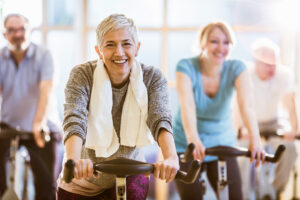Stay Cool in the Summer Heat to Prevent Joint Injury

Are you looking for ways to stay active this summer but are worried about aggravating your arthritis? Research shows people with arthritis benefit from moderate exercise to relieve pain and improve mobility, but hydration and breaks are essential to prevent injury.
One in Five Americans Has Arthritis
About 53.2 million adults in the United States, or 21.2 percent of the population, have arthritis. The National Health Interview Survey between 2019 and 2021 found one in five Americans was diagnosed with arthritis, rheumatoid arthritis, lupus, fibromyalgia or gout (CDC).
The survey also found arthritis was …
- More common in women compared to men.
- Less common with a college degree or higher.
- More common among veterans compared to non-veterans.
- More common as people age.
A Sedentary Lifestyle Makes Arthritic Symptoms Worse
Your activity level has a significant impact on arthritis and joint pain. Arthritis is more prevalent among sedentary adults (30.9 percent) compared to adults who meet physical activity recommendations (18.8 percent).
Inactivity due to arthritis can contribute to other chronic conditions like heart disease, obesity, diabetes and functional challenges.
Mild to Moderate Exercise Can Increase Mobility and Reduce Pain
Summer is a perfect time to enjoy outdoor activities and sports. Low-impact exercises like walking, biking, swimming and pickleball can benefit your heart as well as your joints and soft tissue.
The Arthritis Foundation suggests 150 minutes of moderate-intensity aerobic exercise or 75 minutes of vigorous-intensity. Any type of physical activity that increases your heart rate for 25 minutes is recommended three times per week. Staying active is essential for joint health because it can circulate synovial fluid to keep joints lubricated.
How to Exercise Safely in Summer Temperatures
In the peak of summer heat, it is a good idea to exercise indoors at a gym or fitness facility equipped with air conditioning and supervision from qualified personnel. Some people prefer to exercise outdoors, but you must take precautions.
“If you plan to exercise in the heat, know your fitness level, take frequent breaks, wear proper clothing, wear sunscreen, avoid [the] hottest times of the day and hydrate, hydrate, hydrate,” said Melanie McNeal, physical and occupational therapy manager in the Joseph Barnhart department of orthopedic surgery at Baylor College of Medicine in Houston.
Swimming can be especially deceiving because you may not realize you are losing water through sweating. It is important to take breaks to get out of the direct sun and hydrate with water or electrolyte drinks.
Six Safety Tips for Outdoor Exercise
- Consider working out in the morning or evening to avoid the hottest parts of the day when the sun is the most intense.
- Wear a sunscreen of at least 30 SPF and reapply it according to the instructions on the bottle.
- Opt for light-colored clothing made of wicking fabric to keep moisture away from your skin.
- Take plenty of fluids with you when you exercise outside. For an hour workout, you will need 40 to 60 ounces of water. It is always wise to bring more than you think you will need.
- Bring a large plastic bag with a cooling towel to apply to your neck and shoulders after your workout or during breaks.
- Wear a hat or sun visor, and always wear sunglasses that offer 100 percent UVA and UVB protection.
Pace Yourself During Your Workout to Avoid Injury
If you are new to exercise, it is important to pace yourself and begin slowly, especially if you have any form of arthritis or an artificial joint. Overexertion can cause dizziness and make you more prone to sprains, fractures and cruciate ligament tears.
Start your workout slowly and gradually increase the intensity. Warm up your muscles with a walk and stretch before you begin. Your stamina will improve and your chances of injury will decrease.
Aquatic exercises are excellent and appropriate for people of all ages, ability levels and body composition. This form of exercise is especially beneficial for joint health, as the buoyancy of the water helps alleviate the impact of your body weight on the joints and connective tissues. Exercises performed in shoulder-height water provide sufficient resistance while being easy on the knees and hips.
Do not get discouraged if you experience stiffness in various parts of your body when you begin a new type of physical activity. It may take six to eight weeks to adjust, but be patient. Maintaining an exercise regime will help your osteoarthritis and joint pain overall.
Start Your Fitness Journey by Taking a Walk
Fitness and joint health do not have to be expensive or complicated. Walking is a free activity that can increase cardio fitness, promote weight loss and reduce the risk of heart disease and hypertension. It also tones muscles and maintains bone mass, which reduces the risk of fractures during exercise or daily activities.
Everyone has different ability levels and challenges, so discuss your workout plans with your doctor or physical therapist. If you experience chronic pain or mobility challenges, call your orthopedist. You may need a supportive brace, pain medication or a procedure to relieve joint pain.
You also might be a candidate for total joint replacement surgery. Hip and knee joint replacements can help increase quality of life, maintain an active lifestyle and improve your mobility for years to come.
